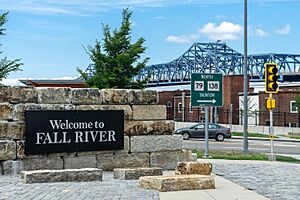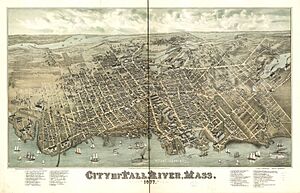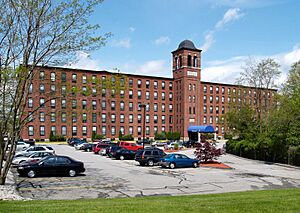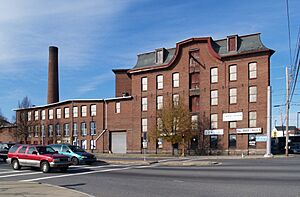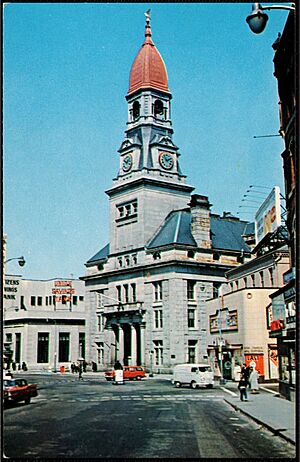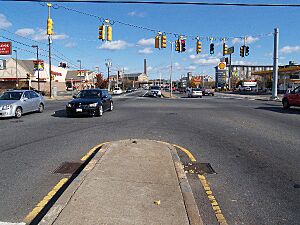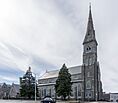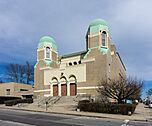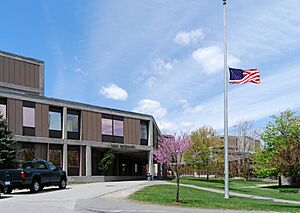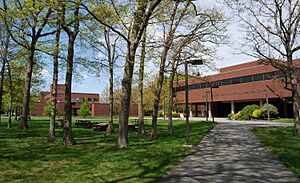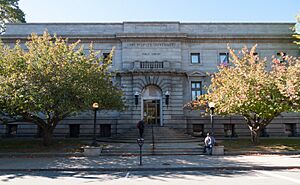Fall River, Massachusetts facts for kids
Quick facts for kids
Fall River
|
|||
|---|---|---|---|
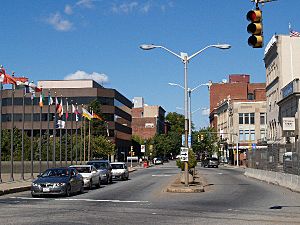
Downtown Fall River in September 2007
|
|||
|
|||
| Nicknames:
"The Scholarship City", "The River", "Spindle City", "Where the River Falls"
"The City of the Dinner Pail" |
|||
| Mottoes:
"We'll Try"
|
|||
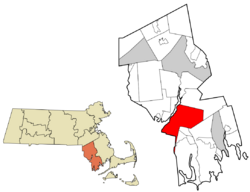
Location of Fall River in Bristol County, Massachusetts
|
|||
| Country | |||
| State | |||
| County | Bristol | ||
| Settled | 1670 | ||
| Incorporated (town) | 1803 | ||
| Incorporated (city) | 1854 | ||
| Government | |||
| • Type | Mayor–council | ||
| Area | |||
| • Total | 40.24 sq mi (104.22 km2) | ||
| • Land | 33.12 sq mi (85.79 km2) | ||
| • Water | 7.12 sq mi (18.43 km2) | ||
| Elevation | 72 ft (37 m) | ||
| Population
(2020)
|
|||
| • Total | 94,000 | ||
| • Density | 2,837.91/sq mi (1,095.73/km2) | ||
| Time zone | UTC−5 (Eastern) | ||
| • Summer (DST) | UTC−4 (Eastern) | ||
| ZIP Codes |
02720–02724
|
||
| Area code(s) | 508/774 | ||
| FIPS code | 25-23000 | ||
| GNIS feature ID | 0612595 | ||
Fall River is a city in Bristol County, Massachusetts, United States. About 94,000 people lived here in 2020. This makes it the tenth-largest city in Massachusetts. Fall River is very close to the Rhode Island state line. Tiverton, Rhode Island is right to its south.
The city is on the eastern shore of Mount Hope Bay. It is also at the mouth of the Taunton River. In the 1800s, Fall River became famous for making textiles (cloth). Even though the textile industry is mostly gone, its history is still a big part of the city. Fall River's motto is "We'll Try." This motto comes from after a big fire in 1843. It is also called "The Scholarship City." This nickname started in 1958 when Irving Fradkin created Dollars for Scholars here.
Fall River is known for its many old textile mills from the 1800s. It also has Battleship Cove. This is where you can see the world's largest collection of World War II naval vessels. One of these ships is the battleship USS Massachusetts. Fall River's city hall is built right over an interstate highway.
Contents
Exploring Fall River's Past
Early Settlements and Growth (1600s-1800s)
When the Plymouth Colony was founded in 1620, the Pocasset Wampanoag tribe lived in this area. The city's name comes from the Quequechan River. This river is about 2.5 miles (4 km) long and flows through the city into the bay. "Quequechan" is a Wampanoag word. It means "falling river" or "leaping waters." In the 1960s, Interstate 195 was built through the city. Much of the river was covered or filled in for the highway.
In 1653, Freetown was settled. It included the northern part of what is now Fall River. In 1683, Freetown became a town. The southern part of Fall River was once part of Tiverton. In 1746, Tiverton became part of Rhode Island. The border was then set near what is now Columbia Street.
In 1703, Benjamin Church built mills on the Quequechan River. Later, in 1714, he sold his land and water rights to Richard and Joseph Borden. This sale was very important later on. It helped the Borden family become leaders in Fall River's textile industry.
During the 1700s, this area was mostly small farms. In 1778, the Battle of Freetown happened here during the American Revolutionary War. The local militia defended well against British forces.
In 1803, Fall River became its own town. A year later, it changed its name to "Troy." But in 1834, it changed back to Fall River. In 1854, Fall River officially became a city.
Becoming a Textile Powerhouse (1800s)
Fall River's textile industry started with mills like the Globe Manufactory in 1811. But the real growth happened along the Quequechan River. Its eight waterfalls made it perfect for factories. The river provided great power for machines.
The Fall River Manufactory started in 1813. The Troy Cotton & Woolen Manufactory opened in 1814. In 1821, Colonel Richard Borden and Maj. Bradford Durfee started the Fall River Iron Works. They made nails and other metal items. This company became very successful.
In 1835, Holder Borden started the American Print Works. This company became the city's largest textile business. It employed thousands of people. Richard Borden also built the Metacomet Mill in 1847. This is the oldest textile mill still standing in the city today.
By 1845, the river's power was fully used. So, mills started using steam engines. This allowed even bigger mills to be built. Fall River's deep harbor was a big advantage. It allowed cotton and coal to be brought in easily. Finished goods could also be shipped out.
The first railroad line came to Fall River in 1845. In 1847, regular steamboat service to New York City began. The Fall River Line was a popular way to travel between Boston and Manhattan for many years.
By 1868, Fall River had more textile spindles than Lowell. It became the leading textile city in America.
Expansion and Growth (Late 1800s)
In 1871 and 1872, Fall River grew very quickly. Many new mills were built. The city's population grew by 20,000 people. By 1876, Fall River made a lot of the cotton cloth in New England. It was second only to Manchester, England, in textile production. This is why it was called "The Spindle City."
Thousands of new workers came to Fall River. Many were Irish and French Canadian immigrants. Over 12,000 company homes were built for them. These were often three-floor "triple-deckers" with many apartments.
Fall River is built on granite rock. Several granite quarries operated here. Many mills and public buildings were built with this stone. It was known for its grayish-pink color.
Challenges and Changes (1900s)
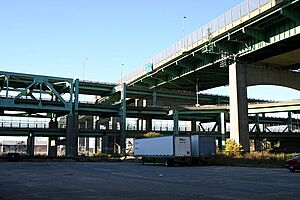
Fall River continued to do well into the early 1900s. The city had a busy downtown with hotels and theaters. New parks, schools, and streetcar lines were built.
From 1896 to 1912, Fall River was home to E. P. Charlton & Company. This was a chain of five and ten cent stores. It later merged with other stores to form the F. W. Woolworth Company.
In 1920, Fall River's population reached its highest point: 120,485 people.
Many of Fall River's cotton mills made print cloth. The American Printing Company was the largest employer. It had 6,000 workers. After World War I, the textile industry slowed down. Mills in the South had lower costs. In the 1920s, some Fall River mills began to close.
In 1928, a large fire destroyed much of downtown. City Hall was damaged but saved. Many buildings in the downtown area today were rebuilt after this fire.
By the 1930s and the Great Depression, many mills closed. The city went bankrupt. The American Printing Company closed in 1934. In 1937, the Firestone Tire & Rubber Company took over its large waterfront plant. This brought new jobs to the city.
After the textile industry declined, smaller companies moved into the old mills. Many were in the clothing industry. They liked the cheap factory space and available workers. The clothing industry lasted in Fall River until the 1990s.
Modern Era Transformations (Late 1900s-Present)
In the 1960s, Fall River changed a lot. The Braga Bridge and Interstate 195 were built. They cut through the city center. The Quequechan River was covered up or moved. Many old buildings were torn down. This included the Old City Hall.
A new city hall, called Government Center, opened in 1976. It was built right over Interstate 195. It was designed in a style called Brutalism.
In the 1970s, several tall apartment buildings were built. Many were for the Fall River Housing Authority. Today, these buildings mostly house older people.
In 1978, the new B.M.C. Durfee High School opened. It replaced an older building. The "new" Durfee is one of the largest high schools in Massachusetts.
Since about 1980, new homes and buildings have been constructed in the North End.
Geography and Natural Features

Fall River covers about 40.24 square miles (104.2 square kilometers). About 17.68% of this area is water.
The Quequechan River and natural granite helped shape Fall River. The river once flowed freely through downtown. It had eight waterfalls that dropped 128 feet into the Taunton River. Fall River was the only city on the East Coast with an exposed waterfall in its downtown.
The city has two large lakes: North Watuppa Pond and South Watuppa Pond. North Watuppa Pond is the city's main water supply. East of North Watuppa Pond is the Watuppa Reservation. This area has thousands of acres of forest. It helps protect the water supply. Copicut Hill is the highest point in Fall River.
The Quequechan River flows out of South Watuppa Pond. It goes through the city, partly underground. It empties into Fall River Heritage State Park at Battleship Cove. The river's waterfalls are now mostly covered by Interstate 195. There are plans to uncover the falls and create a bike path along the river.
In the south end, Cook Pond is located. It was once called Laurel Lake.
Fall River is part of the South Coast region of Massachusetts.
City Sections and Areas
Interstate 195 divides the city into two main parts. Each part has its own neighborhoods.
Northern Neighborhoods (North of I-195)
- Waterfront/Battleship Cove (near the Taunton River)
- The Highlands (divided into Lower and Upper Highlands)
- Fall River Industrial Park ("Airport Road")
- Fall River/Freetown State Forest
Southern Neighborhoods (South of I-195)
- Flint Village ("The Flint")
- Globe Village (near Cook Pond)
- Townsend Hill
- Maplewood
Parks and Green Spaces
Fall River has 23 city parks and playgrounds. Three of these were designed by famous landscape architect Frederick Law Olmsted.
- Kennedy Park (Olmsted, 1868): 54 acres with sports fields and a playground.
- North Park (Olmsted, 1901): 25 acres with sports fields and a skate park.
- Ruggles Park (Olmsted, 1903): 9 acres with a basketball court and playground.
- Bicentennial Park: 2 acres with a boat ramp.
- Lafayette Park: 11 acres with a swimming pool and sports courts.
- Quequechan River Rail Trail: A 2.5-mile bike path.
The city also has state parks. These include Fall River Heritage State Park and Freetown-Fall River State Forest.
People and Cultures
| Historical population | ||
|---|---|---|
| Year | Pop. | ±% |
| 1810 | 1,296 | — |
| 1820 | 1,594 | +23.0% |
| 1830 | 4,158 | +160.9% |
| 1840 | 6,738 | +62.0% |
| 1850 | 11,524 | +71.0% |
| 1860 | 14,026 | +21.7% |
| 1870 | 26,766 | +90.8% |
| 1880 | 48,961 | +82.9% |
| 1890 | 74,398 | +52.0% |
| 1900 | 104,863 | +40.9% |
| 1910 | 119,295 | +13.8% |
| 1920 | 120,485 | +1.0% |
| 1930 | 115,274 | −4.3% |
| 1940 | 115,428 | +0.1% |
| 1950 | 111,963 | −3.0% |
| 1960 | 99,942 | −10.7% |
| 1970 | 96,898 | −3.0% |
| 1980 | 92,574 | −4.5% |
| 1990 | 92,703 | +0.1% |
| 2000 | 91,938 | −0.8% |
| 2010 | 88,857 | −3.4% |
| 2020 | 94,000 | +5.8% |
| 2022* | 93,682 | −0.3% |
| * = population estimate. Source: United States Census records and Population Estimates Program data. Source: |
||
Fall River has a rich mix of cultures. This comes from its history as a place where many immigrants arrived. You can see this heritage in the city's churches and restaurants. The "Banners of Allegiance" at Gromada Plaza celebrate these different nationalities.
The city hosts several cultural festivals each year. The biggest is the Great Feast of the Holy Ghost. It happens every August at Kennedy Park. Over 100,000 people visit this four-day event. It includes parades, music, and food.
Each summer, Fall River has a Fourth of July fireworks display. It takes place at Heritage State Park and Battleship Cove.
Arts and Entertainment
Many groups work to support the arts in Fall River. They use empty mill buildings for studios and performance spaces. The Narrows Center for the Arts hosts many national and international music acts. There are also plans to create an Arts District downtown. Fall River has many Portuguese and community bands that perform all year.
In 2020, artists Harry Gould Harvey IV and Brittni Ann Harvey opened the Fall River Museum of Contemporary Art (Fall River MoCA). It is in a former mill building. The museum aims to show art that connects with the global art world.
Religious Life
Fall River is mainly a Roman Catholic city. This is because many French Canadian immigrants settled here first. Later, Portuguese immigrants also arrived. St. Mary's Cathedral was founded in the 1850s. Santo Christo Parish is known as the "Mother Church" for Portuguese parishes. Other important Catholic churches include St. Anne's Church.
Historically, the Highlands neighborhood had many Protestant churches. The city also has a Jewish community. Temple Beth-El was founded in 1924. More recently, people from Cambodia and India have built temples in the city.
Learning and Education
Public Schools in Fall River
Fall River Public Schools manages all public schools in the city. Fall River has one public high school, B.M.C. Durfee High School. Many notable people have graduated from Durfee.
The city is also home to Diman Regional Vocational Technical High School. This school serves Fall River and nearby towns. Chef Emeril Lagasse is a Diman graduate.
Private and Higher Education
Fall River has several private and religious schools. These include Catholic schools and a Christian academy. Atlantis Charter School is a Pre-K through 8 school. It focuses on marine science.
University of Massachusetts Dartmouth has two locations in Fall River. Bristol Community College is a two-year college. It offers associate degrees and programs to transfer to four-year schools.
Espirito Santo School opened in 1910. It was the first Portuguese elementary school in the United States. Most of its students today are of Portuguese heritage. Many are bilingual.
City Resources
Public Library
Fall River started its public library in 1860. The city spends about $20 per person on its library each year.
The main library building is at 104 North Main Street. It opened in 1899. It was designed in the Renaissance Revival style. It is built from local Fall River granite. The building was renovated in the late 1990s and early 2000s.
The library system also has two smaller branches. These are the South End Branch and the East End Branch. The Fall River Historical Society also has a library for local history.
Getting Around Fall River
Fall River has always been a key spot for transportation. This is because of its location on the Taunton River.
The Slade's Ferry Bridge connected Fall River to Somerset in 1875. It was used until 1970. The Brightman Street Bridge opened in 1908. It was a drawbridge. A new bridge, the Veterans Memorial Bridge, opened in 2011.
Construction on the Charles M. Braga Jr. Memorial Bridge began in 1959. It opened in 1966. This large bridge spans 1.2 miles (1.9 km). It was built along with Interstate 195. The bridge is named after Charles M. Braga Jr., who died at Pearl Harbor.
Roads and Highways
Interstate 195 is the main highway through Fall River. It connects the city to New Bedford and Cape Cod to the east. To the west, it connects to Providence.
Fall River is also served by several other routes:
 U.S 6 enters from Somerset and goes east through the city.
U.S 6 enters from Somerset and goes east through the city. MA 24 enters from Tiverton. It runs along the eastern edge of the city.
MA 24 enters from Tiverton. It runs along the eastern edge of the city. MA 79 starts near Battleship Cove. It goes north along the river.
MA 79 starts near Battleship Cove. It goes north along the river. MA 81 enters from Tiverton and ends downtown.
MA 81 enters from Tiverton and ends downtown. MA 138 also enters from Tiverton. It crosses the Taunton River into Somerset.
MA 138 also enters from Tiverton. It crosses the Taunton River into Somerset. MA 177 briefly passes through the southeastern edge of the city.
MA 177 briefly passes through the southeastern edge of the city.
Train and Bus Services
Fall River used to have passenger train service until 1958. A new project called South Coast Rail will bring MBTA Commuter Rail service back to the city. A new station is being built.
The Southeastern Regional Transit Authority (SRTA) provides bus service in Fall River. It also serves nearby towns. Buses leave from the Louis D. Pettine Transportation Center. You can also take buses to Providence, Tiverton, and Newport, Rhode Island. Intercity bus service to Boston and Hyannis is also available.
Air and Water Travel
Fall River Municipal Airport was a small airport for many years. It closed in 1996. Now, the closest airport for small planes is New Bedford Regional Airport. For bigger flights, you can go to T.F. Green Airport in Rhode Island or Logan International Airport in Boston.
The Fall River Line Pier is a major port. It handles commercial fishing and cargo shipping. A water taxi service started in 2024. It connects different parts of the city's waterfront.
Fall River's Sports History
Soccer in Fall River
Fall River has a long and proud history in soccer. Immigrants from England and Scotland first brought the game here in the 1880s. Later, immigrants from Portugal helped keep soccer popular.
Between 1888 and 1892, Fall River teams won the American Cup five years in a row. One team, the Fall River Rovers, also won the 1917 National Challenge Cup. Thomas Swords, a local player, was the captain of the U.S. team in their first official international game in 1916.
In the 1920s and early 1930s, the Fall River F.C. was one of the best soccer clubs in the U.S. They won the National Challenge Cup four times. Two famous players, Billy Gonsalves and Bert Patenaude, grew up in Fall River. They both played for the U.S. team in the first World Cup in 1930. Patenaude scored the first ever hat-trick (three goals in one game) in World Cup history!
In the 1940s, Ponta Delgada S.C. was a very successful amateur team. In 1950, two of their players, Ed Souza and John Souza, played in the World Cup. They helped the U.S. team beat England 1–0.
In 2011, Andrew Sousa became the first Fall River native to play in Major League Soccer. In 2019, two local clubs, Fall River Football Club and Fall River Marksmen FC, returned to the field.
Places to Visit in Fall River
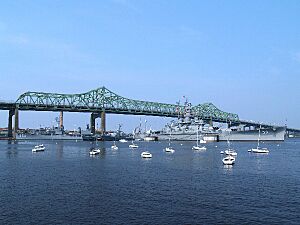
- Battleship Cove: See the world's largest collection of historic naval ships, including the USS Massachusetts.
- Lincoln Park Carousel: A restored carousel from the 1920s, located at Battleship Cove.
- Fall River Heritage State Park: A beautiful park on Fall River's waterfront.
- The Marine Museum at Fall River: Learn about the city's maritime history.
- Freetown-Fall River State Forest: A large forest area for outdoor activities.
- Kennedy Park, North Park, and Ruggles Park: Parks designed by Frederick Law Olmsted.
- Lizzie Borden Bed and Breakfast Museum: The historic home of the Borden family.
- Maplecroft: The home where Lizzie Borden lived after the famous events.
- Oak Grove Cemetery: A historic cemetery.
- Barnard's Folly: A group of historic triple-decker houses.
- Granite Mills: Two historic cotton textile mills.
Famous People from Fall River
- Lizzie Borden (1860–1927): A well-known figure in Fall River history.
- Nathaniel B. Borden (1801–1865): A businessman and politician.
- Colonel Richard Borden (1795–1874): A key figure in the city's mill industry.
- Dave Brinnel: A musician and TV producer.
- David Glendenning Cogan (1908–1993): A famous eye doctor.
- Jasiel Correia (born 1991): A former mayor of Fall River.
- Morton Dean: A television news anchor and author.
- Diesel (Mark Denis Lizotte): An Australian singer-songwriter born in Fall River.
- E. J. Dionne: A journalist and political writer.
- Robert Dollard: The first Attorney General of South Dakota.
- Greg Gagne: A Major League Baseball shortstop who won two World Series.
- Brandon Gomes: A former baseball player and current general manager for the Los Angeles Dodgers.
- Leslie Gourse: A jazz writer.
- Hank the Angry Drunken Dwarf (Henry Joseph Nasiff Jr.): An entertainer.
- Chris Herren: A professional basketball player for the Denver Nuggets and Boston Celtics.
- Louie Howe: A political advisor to President Franklin D. Roosevelt.
- Thomas J. Hudner, Jr.: A Naval aviator and Medal of Honor recipient.
- Sam Hyde: An American comedian.
- Napoleon A. L'Herault: A lawyer and Minnesota state senator.
- Emeril Lagasse: A famous celebrity chef.
- Tom Lawlor: A professional mixed martial artist.
- Marc Megna: An American and Canadian football player.
- Ernest Moniz: The 13th U.S. Secretary of Energy.
- John Moriarty: A pianist and music professor.
- Bert Patenaude: A professional soccer player who scored the first World Cup hat-trick.
- Irving Picard: An attorney known for his work in the Madoff scandal.
- Joe Raposo: A songwriter for Sesame Street.
- Chris Santos: A celebrity chef.
- Ronald A. Sarasin: A politician.
- Winston Sharples: A composer for cartoons.
- Andrew Sousa: A professional soccer player.
- George Stephanopoulos: A co-host of Good Morning America.
- Tecia Torres: A professional mixed martial artist.
- Susan H. Wixon (1839–1912): A writer, editor, and educator.
See also
 In Spanish: Fall River para niños
In Spanish: Fall River para niños






